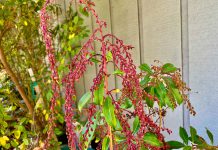
I’ve been worried about the bees lately. Can’t be easy being a bee given the severe weather we’ve had this winter. They’ve also had to deal with habitat loss, pesticides, climate change, pests like mites and pathogens such as viruses, bacteria and fungi. What can I do to help bees?
There are 1,600 species of native bees in Santa Cruz County. They are solely responsible for pollinating many of our native plants. Being solitary, they do not make a hive but make nests underground or live in wood, one female per nesting hole and she lays her eggs there.
Leaving areas in your garden near flowering plants un-mulched helps her find a nesting hole. The hard-working females mate, make nests, collect pollen for their young and lay eggs. Males live to mate and only pollinate inadvertently when they visit flowers for nectar to fuel their flight.
Common native bees in our area are the yellow-faced bumble bee and the long-horned bee, which has stripes a little like a yellow jacket. The hard working bumble bee is easy to identify from its bright yellow facial hair and yellow bands on their backs and abdomens. Female bumble bees’ hind legs widen to form pollen baskets often filled with bright yellow, moistened pollen pellets.
The long-horned native bee gets their name from the long antennae of the males, although the females do not have this. Males may be seen by day jostling for female attention above a patch of blooming plants while the females are collecting pollen. Only the females have branched hairs on their legs for carrying pollen.
Bees eat two things: nectar, which is loaded with sugar and is their main source of energy, and pollen, which provides proteins and fats. Some of the common native plants that are recommended for our area to attract bees of all types include yarrow, columbine, California poppy, coral bells, silver lupine, penstemon, ceanothus, toyon, big leaf maple, mahonia, monkey flower, buckwheat, western azalea and purple sage.
Common garden plants that can attract bees and provide pollen in your landscape and vegetable garden are herbs, such as African blue basil, bee balm, oregano, mint, catnip and cat mint, borage, rosemary, chives, hyssop, dill, comfrey and fennel. Edibles that attract bees are blueberry, pumpkin, squash, sunflower, blackberry, hazelnut, artichoke, beans, cucumber and peas.
Crabapple, iris, lavender, salvia, aster, coreopsis, sunflowers, monarda, aster, butterfly bush, sweet alyssum, alstroemeria, red hot poker, gloriosa daisy, verbena, scabiosa, coneflower and echium also attract bees of all types.
The higher temperatures that come with climate change can affect a bee’s ability to detect a flower’s pollen. A flower’s scent is what tells a bee that nectar is present. If the weather gets too hot, the plant will spend less energy on producing fragrance and just try to survive.
When flowers stop emanating these enticing smells, some bees have a tough time finding food and may abandon certain areas. Studies have shown that warming climates have already affected our Central Coast bumblebee population during the past 30 years, especially the California bumblebee.
In your own garden, an abundant and healthy population of pollinators can improve fruit set, quality and size. Crops raised in California depend on both domestic honeybees and native bees for pollination of almond, blackberry, cucumber and artichoke crops.
Honeybees and native bees need help to survive, and we’re the ones to give it. Besides planting nectar and pollen sources, you can help by buying local honey, which supports beekeepers. Use only organic pesticides and avoid applying during mid-day hours when honey bees and pollinators are most likely to be out foraging for nectar and pollen on flowering plants and only then if you can’t control a pest with any other methods, including pest management techniques.
Help save the bees.
Jan Nelson, a landscape designer and California-certified nursery professional, will answer questions about gardening in the Santa Cruz Mountains. Email her at ja******@*ol.com, or visit jannelsonlandscapedesign.com.












